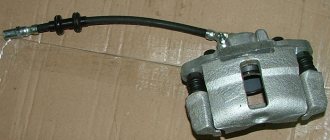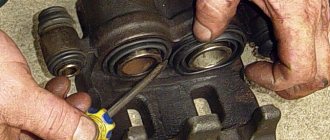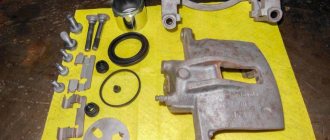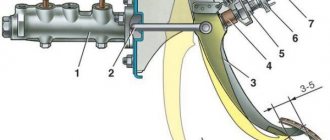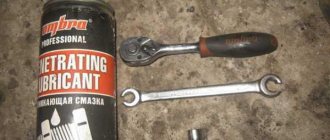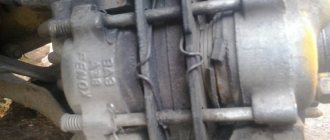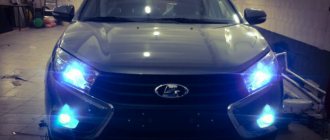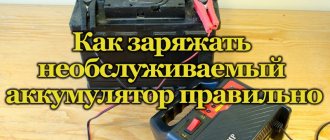Rear caliper guides serve several purposes. Firstly, they are responsible for the absence of ringing of the car’s brakes, and secondly, for the uniformity of braking. The main problem is that this element wears out quite quickly, although a lot depends on the make of the car. Let's see how to lubricate and, if necessary, change the caliper guides yourself.
Some general information
Before starting work, you need to decide what exactly the problem is. The thing is that humming and creaking during braking can occur for several trivial reasons. As a rule, this is critical wear of the part or a complete or partial lack of lubrication under the boot. This work can be called easy in terms of complexity, the only problem may arise if the anthers are stuck, but this can be solved quite quickly. To begin with, it is advisable to install the vehicle on an inspection hole or use a lift. In most cases, a regular jack is sufficient. We remove the wheel and see our actual problem area, which we will have to work with in the near future. If everything is very dirty and nothing is clear, then we take a metal brush in our hands and carefully clean everything. Be careful not to damage the boots, as they are made of thin rubber.
Necessary tools
Let's take a look at the tools right away. The first step is to find an original repair kit for the rear caliper, which consists of a number of spare parts, such as a guide and piston boot, lubricant, cuff, etc. To make the replacement and lubrication process take as little time as possible, get a hammer and a flat-head screwdriver, preferably Have a set of sockets and a torque wrench with you. You should have a clean rag at hand, as you will have to work with lubricant. If the room is dark, then install additional lighting, maybe a special lamp, it will be much more comfortable. Now you can move on to the practical part of solving the problem. To do this, remove the rear wheel from the car, first lifting the side with a jack and installing wheel chocks in front of the vehicle.
Caliper repair
- The housing in which the piston (cylinder) is mounted.
- Bypass valve.
- Sealing ring.
- Piston (cylinder).
- Cylinder boot.
- Retaining ring.
- Frame.
- Pressure bar.
- Pads.
- Guide boot.
- Guides.
- 14. Fastening bolt.
- Brake hose.
To repair calipers we will need the following materials:
- Caliper piston lubricant
- Caliper Guide Lubricant
- Guide block lubricant
- Brake cleaner or any cleaning agent
- Brake Caliper Repair Kit
- Copper brake hose O-rings. If new ones are not found, and the old ones are not very compressed, then you can go over them with a file and grind off the protrusions. But it’s better, of course, to have new ones in stock.
- If it turns out that the piston or guides of your caliper have large holes and pockets of corrosion, then you will need to purchase them as well.
- Possibly brake fluid for topping up
The kit includes two guide boots, a piston boot, a cuff and a cap for the bleeder fitting.
To repair the caliper with your own hands, we will need the following tools:
- metal brush
- medical syringe
- spanners. In my case, 10 and 12 mm
- clean rags
- a good screwdriver or a small tool
- two small packages
- soft wire
- preferably an assistant. We don’t need it for work, but cleaning the ram with clean hands and bringing beer at the right time will be just right. Also, at the very end, he will help you press the brake pedal a couple of times to bleed the brakes to make sure there is no air in the system.
We continue repair work
If you notice that the brake caliper guides are rusty, replace them immediately. If the condition is satisfactory, then you can leave it. Don't forget to remove the pad guides; as a rule, they snap directly into the caliper bracket. Now let's start cleaning the removed elements. To do this, you can use sandpaper (fine-grained). Before applying lubricant, degrease the parts. Do not forget to carry out exactly the same actions with the pad guides, since during operation dirt and water get under the boot, which significantly reduces the performance properties of lubricants. After this, you can install new spare parts, or old ones, at your discretion. After the unit is assembled, take a wire brush and go over the brakes, look at the degree of wear of the pads; it is possible that they will soon have to be changed.
Wedge, overheating, corrosion: everything you need to know about brake caliper maintenance
What is a brake caliper?
The caliper is the thing that holds the brake pads and presses them against the brake disc when you press the pedal. In appearance it is a harsh piece of iron, but deep down it is a rather delicate mechanism that requires care and affection. More precisely, lubricants. It works quite simply: when we press the brake pedal, brake fluid is supplied to the caliper through lines (tubes and hoses). It presses on the piston, which comes out of the caliper body and presses on the pads. Depending on the design of the caliper, there may be one piston, or perhaps two or more. If the piston is located only on the inside of the disc, then they speak of a caliper with a floating caliper. In this case, the piston presses only on the inner pad. Under its influence, the pad is pressed against the disc, and the bracket moves along the guides and presses the second pad (outer). This is the simplest design that is used on most budget cars. And the features of this design explain the fact that the inner pad usually wears out faster than the outer one: it is pressed against the disc faster and spends more time in contact with it than the outer one. If the pistons are on both sides of the disc, then the design is called fixed. The principle of operation is exactly the same as that of a floating caliper, but the pads are pressed against the disc equally on both sides. The brakes in this case are more effective, but most car enthusiasts will not notice the difference. However, on heavy machines, a fixed caliper is very common. Well, how do the pads move away from the disc after the driver releases the brake pedal? Usually, under the action of a rubber seal (cuff), the piston simply moves slightly away from the disk. This movement is very small - tenths of a millimeter. On the one hand, this is good: the closer the pads remain to the disc, the faster they can start braking when you press the pedal. But on the other hand, if the caliper is not completely working, the pads remain in contact with the disc. We will talk about this situation a little lower. Some calipers use special springs to spread the pads. But again: only not the cheapest cars are lucky with them. Budget cars with a floating caliper in the caliper have a simpler mechanism - the same as described just above. So what can go wrong with the caliper? To find out, let's go to the well-known company Volk Brake Performance, whose specialists not only repair and service brakes, but also build real tuning brake systems. There they will tell us everything about calipers.
Corrosion of metal
Our main question:
What problems could the caliper have?
In principle, there is only one main malfunction here: loss of mobility of the piston or caliper bracket guides. But the reasons for this malfunction may differ. Of course, the glands stop moving solely due to rust. Why does she appear? The first reason
is the natural ingress of dirt, water and dust under the anthers of the piston and guide bracket during operation. Theoretically, there should be a lubricant there, but in practice, over time it turns out to be an abrasive. In megacities, where roads are generously treated with reagents in winter, the abrasive is especially aggressive. As a result, the mobility of the parts is lost and the caliper becomes sour.
Somehow, out of curiosity, the service specialists decided to check under what pressure it was possible to move a piston that could not be pushed out with compressed air. We placed the caliper under a hydraulic press and pressed it firmly. It’s hard to believe, but a force of 150 kg could not move the piston. Well, brake fluid won’t move such a piston, even less so.
Now let's move on to the second question:
What are the dangers of a rusted piston and guides?
In the easiest situation - a skewed brake pad. The purpose of the caliper bracket is not only to bring the pad to the disc, but also to align the position of the pad relative to the disc. The block should be pressed evenly over the entire surface. If the mobility of the bracket guides is impaired, the block stands at an angle. In this case, the uneven wear of the pad will be very noticeable. And, of course, it will wear out faster than it should. In addition, the braking efficiency on a wheel with soured guides will be lower. The driver may not always notice this, but on a slippery road the effect will be unexpectedly unpleasant.
Uneven pad wear
The consequences of a soured caliper piston are much more serious. The force that presses the pad to the disc under brake fluid pressure is much greater than that applied to the pad from the rubber seal or spring. Therefore, a rusty piston may still be able to press the pad to the disc, but the pad will no longer be able to move away from the disc. And the driver has no choice but to drive on the braked wheel. What does this mean? Nothing good.
Firstly, this can be noticed by a sudden increase in fuel consumption. Everything is simple here: the free run becomes smaller, the car drives poorly when coasting, and it no longer reacts so readily to the gas. You have to press the pedal more, the consumption increases. But that's not the worst thing. What’s worse is that both the pads and the disc fail due to constant friction. The pads seem to be consumables, and to hell with them, but I feel sorry for them too. Good pads cost money, and replacing them at a service center is also not free. During constant friction against the disc, the pads are literally fried. Then they begin to crumble: the binding plastic material burns out, and the pads begin to “dust” with solid fractions. Particles land on the disc and scratch it. Sometimes it gets to such a state that the disc has to be changed, or at best, sharpened.
Consequences of pad overheating
The disk also overheats. Sometimes traces of local overheating are even visible on the disk. And this overheating is much more dangerous than it seems. We are used to thinking that the worst thing is the possibility of turning an overheated disk into a figure eight. Yes, driving with a driven disc is below average pleasure. At high speeds, the brake pedal hits your foot, and unpleasant wave-like braking appears at low speeds. In fact, the consequences are even more serious: the composition of a chronically overheated disc changes, which negatively affects its adhesion to the pad. The block simply begins to slide along it, practically without slowing down the car.
Local disk overheating
If you chronically neglect caliper maintenance, over time you will have to not only change the lubricant and rubber bands, but also the entire body and piston: corrosion appears on them, which prevents the sealing rings and the piston itself from ensuring a tight fit. And in this case, the brake system can only be saved by replacing the caliper. This will cost significantly more than servicing.
Service specialists also recalled the most dangerous consequences they had to face. Three times we encountered broken discs (this is the most serious consequence), and in some situations the brake fluid boiled. The new brake fluid, of course, will not boil. But if it is not changed for many years, the water content in it increases over time (brake fluid is very hygroscopic), and when the amount of water approaches approximately 4%, the fluid may boil. Well, a vapor lock in the brake line is almost a crime: you can kill yourself. And another interesting consequence of severe overheating is grease leakage from the wheel bearing. The case is rare, but quite probable: the lubricant becomes too liquid and simply flows out of the hub. There is a chance to do not only repair the caliper, but also replace the bearing. And for those on whose cars the bearing is replaced as an assembly with the hub - also by replacing the hub. This is where the purely theoretical part can end. I'm not sure I said anything new, but I had to say it. Now let's move on to the more practical part: what and how to do to brake correctly.
The main thing is lubrication!
A minute from the “Obvious - Incredible” section: the most useful thing for caliper health is lubricant. It performs several functions. The first is obvious: it ensures the mobility of the caliper structural elements. The second is not so obvious, but also not very incredible: the lubricant prevents dust, dirt and water from getting inside the caliper body. Therefore, when rebuilding a caliper, they try to use the best lubricant that has proven itself well. Thank God, gone are the days when there was nothing better than solid oil or lithol. There is a large selection of lubricants on the market now, so there is plenty to experiment with. At Volk Brake Performance, experiments with lubrication ended about eight years ago, when the craftsmen switched to products from the domestic company VMPAUTO.
For mounting the cuff and installing the piston, MC 1600 lubricant is usually used.
According to service specialists, it not only works well, but is also easy to use: its white color allows you to control the uniform application of lubricant without skipping. The same lubricant is used for the threads of the fitting.
If corrosion has not yet eaten up the caliper body, then it can be cleaned, lubricated and installed on the car. Sandblasting is used for cleaning, otherwise it is very problematic to remove all dirt and rust from it.
But the O-rings and anthers cannot be reinstalled in any case. It’s good that there are repair kits for sale for almost any calipers. Volk Brake Performance tried different kits, but ultimately settled on Frenkit products. It sounds like an advertisement, but if the reviews are good, then why not.
When assembling the caliper and installing the pads, you simply need to use the appropriate lubricants. It is highly desirable that they be good. As I already said, this service loves VMPAUTO products, and there are no complaints about the quality. You just need to understand what to lubricate and with what. You can, of course, get by with one universal lubricant MC 1600; it has been used in service for years, and it is suitable for the caliper guides, the piston, and even the back side of the pads.
But there are those who prefer to use specialized lubricants. For example, PAG is a polyalkylene glycol based lubricant designed specifically for caliper and brake piston guides. Its main feature is its wear resistance during small movements, which is why it is so suitable for caliper guides. This lubricant does not coke and does not cause deformation or destruction of rubber boots.
The most important thing in assembly is to do everything carefully. Cuffs that are distorted during installation, torn anthers - all this will reduce the results of the work to zero. And a simply poorly cleaned caliper cannot be assembled so thoroughly that it will survive until the next maintenance.
By the way, how often should the calipers be serviced?
Cherish and protect
The frequency of maintenance of calipers is a complex issue. It is best to carry out their prevention every time you replace the pads. But it’s difficult to navigate by mileage. Someone manages to finish off the pads in 15-20 thousand kilometers, others drive a set of 50 thousand. It is difficult to somehow calculate a normal interval with such a spread. But there is a time guideline - one year. The caliper needs to be cleaned and lubricated once a year. Of course, it will drive without this operation, but its service life will be noticeably shorter. In addition, the frequency of maintenance depends on many other factors. As I already said, if reagents are abused in your city in winter, it is better to shorten the interval. And it would be a good idea when washing a car to wash the brake mechanisms, if possible, at least from the outside. Reagents shorten the life not only of calipers, but also, for example, of brake pipes, which corrode faster. An extra wash won't hurt them. Of course, the calipers of cars that often drive through mud will require increased attention. Do you like fishing, hunting or mushrooms? Don't forget to keep your brakes clean. Experts have noticed another interesting factor that affects the service life of calipers - the type of wheel rims. On the same cars, calipers last much longer if the car rides on alloy or forged wheels. It turns out that stamped disks reduce their service life. They cannot explain this fact unambiguously. There is an assumption that with stamps it is more difficult to reach the calipers when washing. Or their cooling is worse. There is no definite answer, but it is a proven fact. So if you drive a stamping machine, check your calipers more often. Well, one last thing: to service calipers, you should not use repair kits and lubricants of unknown origin. The products of Frenkit and VMPAUTO were recommended to us in a specialized workshop that we trust, and the names of these manufacturers sounded to us solely out of great love for cars. And to the brakes, without which we cannot survive.
Which lubricant to choose?
The question is quite sensitive for any motorist. In order for the caliper guides to work under normal conditions and ensure proper safety while driving, it is recommended to use high-temperature lubricant. This will almost completely eliminate the possibility of jamming or jamming of the brake pads while driving. When you carry out repairs, be sure to pay attention to the condition of the guide boot. The fact is that dirt and other foreign inclusions get underneath it. The lubricant is washed out and loses its original properties. If the front caliper guides are sticking, then with a 99% probability we can say that the problem is in the lubricant. Every brake pad replacement should include an inspection of the guide. Remove the boot, remove the layer of old grease and apply a new one to the grease-free surface. The staples, as well as the metal surfaces of the pads, must be processed. For this purpose, anti-charging paste is used. The lubricant can be containing copper or with the addition of ceramics (magnesium, disulfide).
Purpose of a car's rear caliper
The rear caliper is the most important part of the braking system.
You can buy it from 15–20 thousand rubles. The price of some original models reaches 150 thousand rubles. and more. This is not surprising - the unit is responsible for the safe operation of the car. The mechanism holds the brake pads, ensuring their tightest fit to the disc - this is how friction occurs and the car stops. Essentially, this is one housing, inside of which there are pistons, seals and other spare parts. Typically a new repair kit includes all of these parts.
About installing a finger on a car
As noted above, if you notice knocking, squeaking or other unpleasant sounds in the brake area of your car, then most likely the problem is in the pads or guides. There are 3 ways out of the situation. Just lubricate everything, install a new repair kit (quite expensive), or if the guides are worn out a lot, install new ones, but from a different car. If the finger is longer than needed, no problem. You can use a metal file and cut it to the desired thickness. After this, it is necessary to remove all burrs from the processed edge so that jamming does not occur during operation. As practice shows, if the diameter of the brake disc matches, then there should be no problems. Likewise, the guide caliper boot should fit on the new “finger” without any unnecessary effort.
Signs of caliper malfunctions
The breakdown of the caliper components and their impending repair can be understood by some signs that occur during braking:
- The car pulls and pulls to the side when braking.
- It feels like when braking you have to put more force on the pedal or, conversely, less.
- The brakes rattle or knock when driving over bumps or when stopping.
- The brakes are jamming, which will be indicated by possible skidding.
- The appearance of brake fluid leaks on the wheel.
- Feedback in the pedal, expressed in a strong pulsation when pressing the brake.
If these symptoms appear, you should not delay repairing faulty caliper elements. You must first figure out why this happened and make repairs immediately.
Anti-knock measures
Most users complain about the repeated appearance of knocking after a comprehensive replacement of the caliper guides or its lubrication. In this case, you can take some measures, for example, use special aluminum tape, but this will only help for a few thousand kilometers. Another good way is to simply install brackets on the caliper. In some cases, these already exist, but if not, then in most cases this method helps solve all problems with creaking or knocking. If you perform all the steps together, the result will be positive. To do this, you need to change the guides, lubricate them before installation, also pay attention to the anthers, or rather, their condition. Install the brackets (springs) and enjoy the result.
A few important points
If, after removing the guide calipers, you notice that the pins are very worn, then there is no point in repairing them; it is easier to replace them. It will be both faster and cheaper. Remember that during city or aggressive driving with frequent braking, you need to buy a lubricant that does not change its composition and properties with increasing temperature. The reason for this is that the discs can heat up to 300 degrees Celsius or even higher. As for the repair itself, this is a rather expensive procedure, which is not always advisable. However, if you still decide to do it, then purchase repair guide pins and drills of a suitable diameter. The whole point is that the purchased finger has a diameter of 10 mm, while the standard one is 9.5 mm. It is bored out, lubricated and put back into place.
